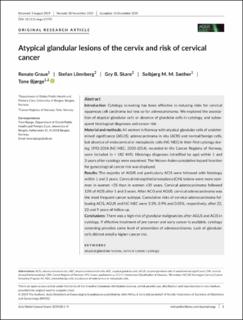Atypical glandular lesions of the cervix and risk of cervical cancer
Graue, Renate; Lönnberg, Stefan; Skare, Gry Baadstrand; Sæther, Solbjørg Makalani Myrtveit; Bjørge, Tone
Journal article, Peer reviewed
Published version

Åpne
Permanent lenke
https://hdl.handle.net/11250/2737864Utgivelsesdato
2020Metadata
Vis full innførselSamlinger
Originalversjon
Acta Obstetricia et Gynecologica Scandinavica. 2020, 99 (5), 582-590. 10.1111/aogs.13790Sammendrag
Introduction
Cytology screening has been effective in reducing risks for cervical squamous cell carcinoma but less so for adenocarcinoma. We explored the association of atypical glandular cells or absence of glandular cells in cytology, and subsequent histological diagnoses and cancer risk.
Material and methods
All women in Norway with atypical glandular cells of undetermined significance (AGUS), adenocarcinoma in situ (ACIS) and normal/benign cells, but absence of endocervical or metaplastic cells (NC‐NEC) in their first cytology during 1992‐2014 (NC‐NEC; 2005‐2014), recorded in the Cancer Registry of Norway, were included (n = 142 445). Histology diagnoses (stratified by age) within 1 and 3 years after cytology were examined. The Nelson‐Aalen cumulative hazard function for gynecological cancer risk was displayed.
Results
The majority of AGUS and particularly ACIS were followed with histology within 1 and 3 years. Cervical intraepithelial neoplasia (CIN) lesions were more common in women <35 than in women ≥35 years. Cervical adenocarcinoma followed 13% of ACIS after 1 and 3 years. After ACIS and AGUS, cervical adenocarcinoma was the most frequent cancer subtype. Cumulative risks of cervical adenocarcinoma following ACIS, AGUS and NC‐NEC were 3.5%, 0.9% and 0.05%, respectively, after 22, 22 and 9 years of follow‐up.
Conclusions
There was a high‐risk of glandular malignancies after AGUS and ACIS in cytology. If effective treatment of pre‐cancer and early cancer is available, cytology screening provides some level of prevention of adenocarcinoma. Lack of glandular cells did not entail a higher cancer risk.
